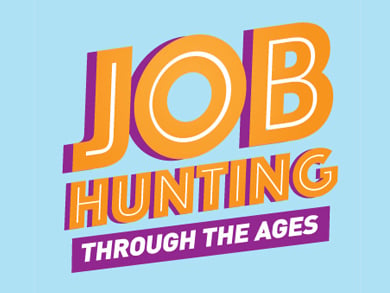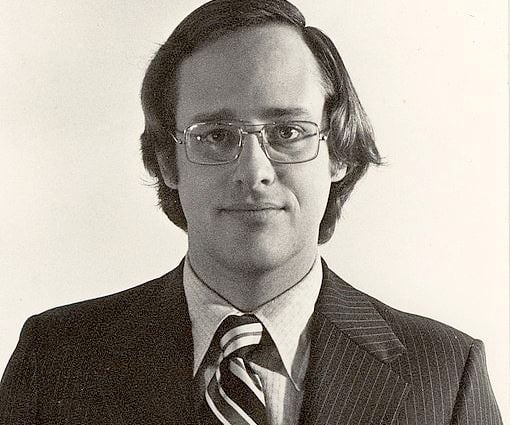The fascinating history of job hunting
February 23, 2017 | By Lisa Dare and Kelly Niles

The ‘70s called. They want their career tips back.
Our office was recently buzzing about a LinkedIn story warning women to avoid wearing expensive rings to job interviews. After all, said the male writer, that diamond alerts the interviewer you don’t need a job.
While younger coworkers were shocked at this throwback, many remembered being given similar advice when starting out. So to help job seekers finally shed the last vestiges of dated advice—and because it’s a fascinating topic—we researched the last 50 years of career and job hunting norms.
A few nuggets we found:
- In the 1970s, your resume had to include your age and weight, among other personal details
- In the 1980s, when shoulder pads and colorful suits conveyed power and ambition, the rule of thumb was: Dress two levels up from the job you want
- In the 1990s, even after job boards started to take off, people still mainly found openings through the newspaper ads (but at least space constraints meant no crazily specific job descriptions)

Fast-forward back to 2017 and technology has changed … well, basically everything. But oddly, while digitalization has made some facets of job hunting much easier, in many ways the experience is just as inefficient and painful as ever.
Job hunting in the 1970s: Collar confusion, ‘girl Fridays’ and smoking in interviews
The 1970s were a time of cultural transition in and out of the workplace. But how you found a job hadn’t changed much since the ‘50s. People still hit the pavement—literally walked around to offices—to hand out resumes. Job ads directed job seekers to inquire in person or by phone. And while computers had just started to enter the mainstream, consumer printers were still a long way off—meaning you had to type your resume on a typewriter.
And while lawmakers were starting to mandate equal opportunity for women and minorities, most companies weren’t exactly embracing it. Experts advised job seekers—and employers expected—that resumes should include personal details, including race, weight, height, family and marital status, health condition and whether you owned your own home.
The general intention was to help employers skirt EEOC regulations by listing the information they couldn’t ask you about on your resume. A Baltimore Sun article from 1979 quotes a management consultant about this advice. “Personnel people know what types they want to hire to meet commitments or to fulfill certain job requirements. … Because of the new laws…you would be better served to disclose more about your background rather than relying on the interview to draw this out.”
1970s dos and don’ts
What you can do:
- Smoke in an interview if the interviewer lights up first
- Coast on one version of your resume
What you can’t do:
- Pick up the lunch tab if you’re female
- Print your resume at home
What we don't miss about the '70s:
- Ads that specify a desired gender
1970s career fashion
Of course, we can all agree fashion has come a long way from the 1970s. (If you harbor any doubt—or are too young to remember—check out this ’70s photo bonanza. Warning: It’s mildly NSFW).
While outlandish clothing was the norm, the rules of dressing for work were the just the opposite: incredibly strict. Job counselors shouted from the rooftops that only the most conservative of blue or gray suits could be worn to interviews. Men were given complicated advice about the width of their collars, and shirts could be worn only in blue, white or gray. Women were admonished to wear skirt suits and warned against wearing expensive jewelry to avoid stirring up resentment (sound familiar?).

Job hunting in the 1980s: Power suits, word processors and mastering the art of the interview
The 1980s began with a recession and ended on the cusp of a technological boon that would transform the American workplace. Employers had to adapt their hiring practices to manage risk in the face of rising employee turnover costs as well as comply with increasing legislation and policies on equal opportunity employment.
For job seekers, the rise of skilled workers, as well as more women in the workplace, made for tough competition for good jobs. It was no longer enough to have the required skills and experience—interviewers were looking to uncover things that weren’t on a resume, like ‘What don’t you do well?’, and asked situational questions to determine a candidate’s management style1, such as ‘Tell me about a time when X happened. What action did you take and what was the result?’ To avoid being caught off guard, it was recommended that job seekers develop a personal script and a power vocabulary.
1980s dos and don'ts
What you can do:
- Fax resumes
- Swap your typewriter for a word processor
- Use video to practice interviewing
What you can’t do:
- Expect to find a top job without networking
- Research a company without a trip to the library
What we don’t miss
- Agonizing over picking the *perfect* resume paper
1980s fashion
Much like the 1970s, the funky and fabulous fashion of the 1980s didn’t always translate into the interview process. Overall, it was recommended that job candidates dress neatly in conservative garments and steer away from strong colors or heavy makeup.
You will never, ever, as long as you live, wear a short sleeve shirt for any job interview, or for any business purpose! —Joe Hodowanes, Dressing for Interview Success, circa 1980s
Young women starting out were cautioned to wear suits—as they convey power in a way dresses do not. With the number of American women in the workforce hitting 50 percent, the pressure to dress like men to be taken seriously was beginning (ever so slightly) to lessen. The “power suit” evolved to include more feminine cuts, as long as they included attributes that left a similar authoritative impression, such as shoulder pads or tweed fabric. (Think: Working Girl, Designing Women, Murphy Brown). Men’s power dressing saw more pinstripes and double-breasted suits, and a drop-off in three-piece suits.
Job hunting in the 1990s: Email, passive job-seeking and—hallelujah!—the internet
In 1997, about 1 in 5 companies used online services for recruiting, whereas nearly half of workers were hired through classified ads.3 However, by the end of the decade those numbers began to change as people became increasingly comfortable using the internet.
The decade saw the genesis of many of the job boards IT job seekers use today:
- Dice launched as a bulletin board system, or BBS, in 1990. Dice.com launched in 1996.
- Monster.com went online in 1994, mostly populated with job descriptions from the newspaper segment of an HR company, Adion. In 1996, they became the first public job search on the internet and the first public resume database in the world.
- CareerBuilder began its start as Netstart, a software company that enabled companies to list job openings on their websites, in 1995.
Job seekers were exposed to more job markets than they would encounter offline, and boards allowed people to become passive job seekers, i.e., to post a resume and let employers find them. Security was a concern as it is today, but in a different way. In a 1998 article, the Wall Street Journal recommended removing personal information, making company, job title and start dates generic so they would be less identifiable.2 (Quite different than today’s mandate to maintain an up-to-date LinkedIn profile!)
1990s dos and don’ts
What you can do:
- Apply for jobs online (job boards and email)
- Easily search jobs in multiple markets and industries
What you can’t do:
- Get too fancy with formatting your resume—it would be removed or muddled depending on the employer’s software
- Rely solely on electronic job search without classifieds and in-person networking
What we don’t miss
- Making mass copies of a resume—only to miss a typo (as Rachel Greene found out the hard way)
1990s interview fashion
After the hustle-bustle/workaholic vibe of the ‘80s, the workplace took a chill pill. People’s priorities in the job search started to shift from solely salary to flex time, telecommuting and relaxed work environments, including a rise in Casual Friday and loosening dress codes. In 1992, Dockers capitalized on the changing mindset and sent a “Guide to Casual Business Wear” pamphlet to 25,000 HR managers across the country.
Yet, interviews remained a different, age-old story. A 1995 New York Times article notes, “Though loafers and sweaters from The Gap are replacing pumps and pin stripes in the corporate wardrobe, the interview outfit has changed little during the last decade.” In interviews, the article advised a navy suit and “inoffensive tie” for men, and (still!) skirts over pants for women. For a refresher, watch Living Single, Ally McBeal or Melrose Place.

Job hunting 2000-2010: Desperation and resume black holes
The 2000s presented serious challenges for job seekers. In the early part of the decade, while the economy was sleeping off the dot-com hangover, many tech workers suddenly found their skills unmarketable. This period was followed by a jobless recovery, and worst of all, the Great Recession.
Major unemployment came to pass as job boards made applying easier than ever. Legions of the unemployed flooded online systems with resumes, which likely sped the adoption of automated screening tools. With a wealth of applicants, employers became incredibly particular about qualifications. Good enough wouldn’t do; qualified candidates were overlooked when they couldn’t check every single box. The use of credit checks also became a new—and often useless—filter for screening out applicants.
The unmanageable flood of resumes created a resurgence in the criticality of networking. Referred candidates were given a much closer look than random applicants, helping bypass the keyword-screening systems.
2000s dos and don’ts
What you can do:
- Apply for a job from a “cyber café”
- Set up a LinkedIn profile (by 2003)
What you can’t do:
- Send a generic resume not specifically tailored to the position
- List Word, Excel, internet and other basic skills on your resume
- Act poorly on social media and expect it not to sabotage your job hunt
- Call the hiring manager
What we don’t miss:
- Networking before LinkedIn adoption made it easier to keep in touch
2000s interview fashion
By the 2000s, some of the hysteria around bright colors and selecting exactly the right socks began to die down. While most professional advice givers still counseled job seekers to err on the side of caution, what job seekers were advised to wear depended largely on the context of the position. Applying for a bank? It might as well be 1950 as far as your wardrobe is concerned. Interviewing with a tech startup? Don’t even think about donning a three-piece suit.
It’s notable that even in the early 2000s, most interview dress advice strongly cautioned women to leave purses at home in favor of a briefcase. The underlying assumption is that it makes sense to downplay femininity in favor of acting like a man.

Present day: What job advice and norms survive
Amazingly, some job search advice has withstood the evolution, fads and quirks of time. You can trust this time-honored advice without worrying it will date you:
- Keep your resume updated – you’ll never know when you need it
- Your resume should be concise and use powerful action words
- Keep a portfolio of your best work
- Really research any company you’ll be interviewing with to understand their culture, landscape and challenges
- Interpersonal skills play a major part in getting a job and advancing your career
- Networking plays a critical role in getting a job; LinkedIn makes it easier to find out who you know at a company you’re interested in working for
Related: Browse our Career Hacker articles to discover practical advice for your IT job search.
Citations:
1“Job Interviews: Questions of Style,” Robert Swain, June 22, 1980, New York Times, Late Edition (East Coast).
2“Your Cyber Career: Using the Internet to Find a Job---Tips on Resumes, Searches—And Security,” Rebecca Quick, March, 5, 1998, Wall Street Journal, Eastern edition.<
3“Surf’s Up! Job Hunters Catch an Internet Wave Web makes job searches faster, cheaper, more thorough,” Shelley Donald Coolidge, The Christian Science Monitor, June 10, 1997.